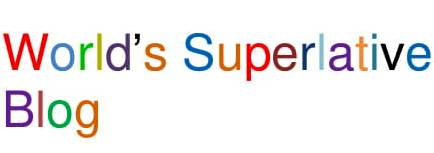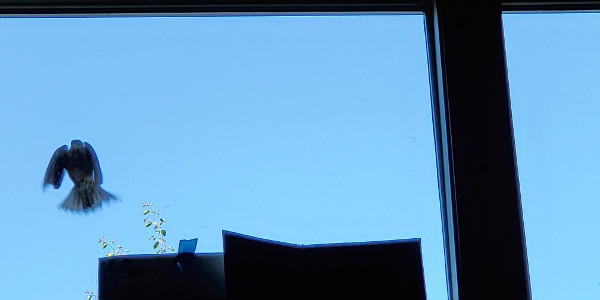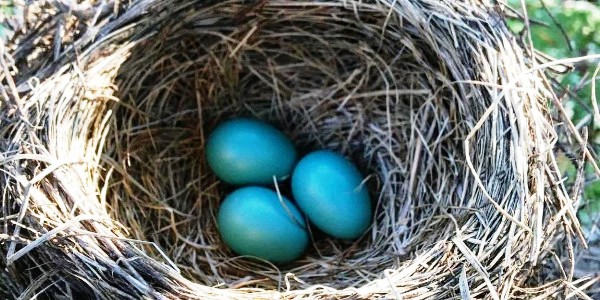Attack of the Mama Robin
I never planned to write a second post featuring a mother robin. Especially immediately following the previous one. But now I have no choice.
The day after I posted my last blog, during our peaceful breakfast we heard a frantic tapping. I ran to the front door, but no one was there. It occurred to me that it might have been Elijah, running late for Passover seder. Then Annie noticed that the racket was coming from the windows above the stairway to the upper floor. Who in the world was making it? Soon enough we saw that it was a bird crashing against a window, furiously attacking its own reflection.
The commotion continued throughout the morning. Finally I was called to action, equally motivated by the noise being extremely irritating and by compassion for the hapless bird. I extracted some cardboard from the recycle bin, stood on my tiptoes on the stairs, and placed it on the windowsill; the idea was to quash the ornithological reflections. The tapping stopped for about ten minutes. Then it began again at full blast. So I went out on the little second story deck with tape and newspapers, covering the windows as far as I could reach. There was blissful quiet for about half an hour.
Then the racket resumed–the bird was charging at various bits of the windows that weren’t covered. What the heck was going on? We got a good look at the bird, and did a search–the attacker was a female robin. Could it possibly be the same one who built the nest and hatched the three babies last spring? Maybe she’d just built a new nest and was defending it against the competition, who unfortunately happened to be a mirror image of herself.
As dusk descended, the assaults mercifully trailed off. But the next morning the persistent tapping and crashing was back. I put up more cardboard and more newspapers, but because the far reaches of the window weren’t accessible, some of the glass remained bare. These gaps seemed to be enough to present the mama robin with a self-image to joust with. Annie went out on the upper deck and joined the fray, clapping her hands, stomping, and yelling, “silly bird—stop it!” I heartily concurred.
On the third day I went out the front door, a level below the windows that were under siege. There was a wobbly line of white poop written across the deck, tracing the blitz path from the katsura tree, which had apparently served as an observation post, to the windows. During the course of the day the line filled in, documenting the cumulative hours spent in theoretical nest defense.
Around the fourth day I noticed with great distress that the thickening white line was sprinkled with red dots—apparently the mama bird had been such an assiduous attacker that she’d injured her beak. That afternoon things were mercifully still. But with a start I realized that this wasn’t merciful at all–perhaps it was so quiet because the robin had pecked herself to death. We were quite saddened , and wondered what else we could have done to prevent her suicide.
Later in the afternoon, while playing Catch the Speeders with my young grandson, I looked up from the driveway and saw a nest nestled in the grapevine which twisted above the outer garage door. Aha! Just as I suspected, the mama robin had indeed been protecting her inauspiciously placed home from a simulacrum of herself.
The next day the tapping began again. I was happy that the mama robin wasn’t dead, and sad that her senseless activity had resumed. It was time to get aggressive. Standing on the upper deck, I reached over to the outer window as far as I dared. I taped up rows of curling, shiny gold ribbons. I attached yet more cardboard. I hung CDs all over the windows. It looked like we’d put up decorations for our grandson’s birthday party.
But still, the mama bird remained in attack mode. Her flapping wings set the sparkly golden ribbons aflutter and made the CDs shimmy, spraying their rainbow patterns out over the world. I went out on the lower deck and peered down at the grape vines above the garage door to see if eggs had appeared. But all I saw were a few dried leaves in the bottom of the nest. Then I examined the nest more closely. It was a perfectly constructed bowl—twigs and moss were intricately intertwined. It was a symmetrical, tidy, and gorgeous creation. Hmm. Maybe a creature that could build such a masterpiece wasn’t so silly after all.
It occurs to me that the same brain that made the robin endlessly strike out at her doppelgänger also directed her to produce an elegant nest that would have been (or, who knows, still might be) perfectly designed to hold her precious eggs. And even if she should not lay eggs this season, or even worse, perishes from her endless dueling with her own image, maybe her activity isn’t so irrational. The same wiring that led her to mount her fruitless multi-day offensive could well have, in ten of her relatives, led to their successfully defending their broods from threats, resulting in the production of twenty or thirty further members of the species. After all, this isn’t about the survival of the individual, but the survival of the species. And down through the centuries this behavior has clearly served her ancestor mama robins well—the proof is that she is here today to protect her nest.
Can we really claim that we humans are more evolved than our bird-brained buddies? We’re perhaps the world’s most expert species in persisting in pointless behavior: We continue to fight wars, even when there’s no chance of victory. We continue to stay in destructive relationships, even when it’s clear there’s no future. We continue to smoke cigarettes, take drugs, drink excessive alcohol, and eat poorly even though we know full well that doing so is at least as damaging as assaulting our reflections.
And alas, with rare exceptions, trying to get our leaders to end a war, or convincing a friend to leave a destructive relationship, or talking someone out of harmful activity is as likely to succeed as hanging sparkly ribbons to stop the mama bird from her self-attacks.
At the risk of ruffling some feathers, I suggest that the mama robin may in some ways actually be a rung or two above us on the evolutionary ladder. At least her misguided actions have utility: they clearly enhance the survival of the species, even if not her own. But it’s hard to see how some our quite irrational human behaviors improve the chances of the continuation of the human race.
The tapping has stopped. The perfect nest remains empty. But the sound of birdsong is everywhere.


